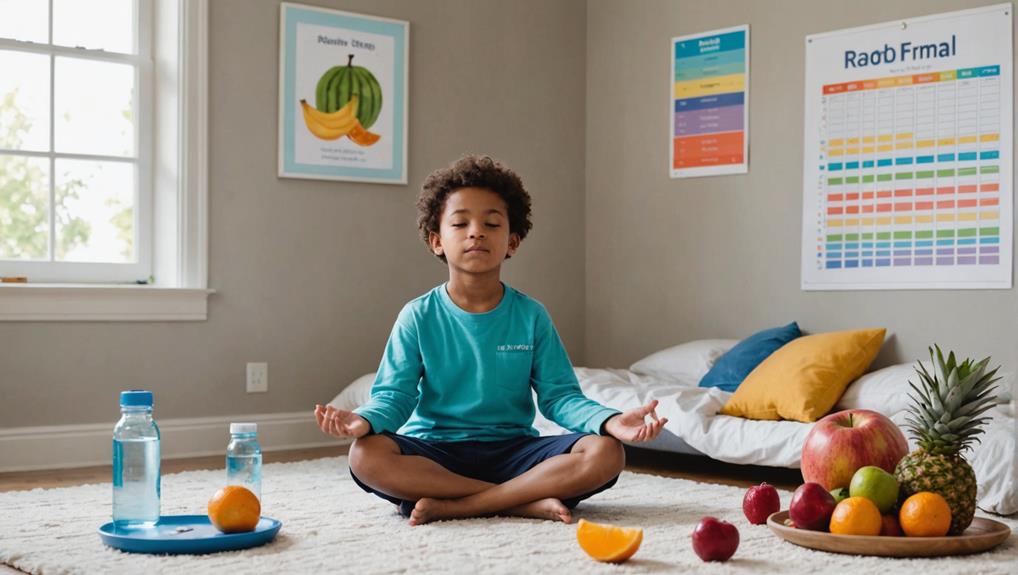For parents grappling with their child’s ADHD, supporting their focus and calm can seem like a challenging task. However, with seven powerful strategies, parents can create an environment conducive to their child’s attention span and peaceful demeanor. From establishing routines and designating study areas to promoting physical activity and nourishing diets, these strategies offer a multifaceted approach to managing ADHD behaviors. What if the key to supporting your child’s focus and calm lies in these methods? Let’s set off on this exploration together.
Key Takeaways
- To enhance focus in children with ADHD, implement a structured environment with consistent routines, clear expectations, and minimal distractions.
- Encourage healthy habits like physical activity, sufficient sleep, and a nutritious diet to support their overall wellness and concentration.
- Establish clear rules and guidelines that are consistently enforced to manage impulsivity and promote positive behavior.
- Utilize sensory integration strategies to manage hyperactivity and impulsivity and improve the child’s attention span.
- To maintain a healthy caregiving environment, prioritize parental self-care, including stress management, regular breaks, and building resilience.
Understanding ADHD in Children
A diagnosis of ADHD in children can be a challenging situation for many parents. It’s important to understand that ADHD is a neurodevelopmental disorder, not a result of inadequate parenting or lack of discipline. This disorder, characterized by delays in frontal cortex maturation and dopamine dysregulation, affects approximately 9.4% of children aged 2-17 in the United States, manifesting through inattention, hyperactivity, and impulsivity.
Children with ADHD often struggle with focus, organization, and self-control—challenges rooted in structural and functional irregularities in the brain. These can impact their academic performance and social interactions, affecting their overall quality of life and causing stress for the child and the family. However, with knowledge and understanding, parents can become strong advocates and provide adequate support for their children.
Understanding ADHD is fundamental for parents to nurture a calm, supportive environment catering to their child’s needs. This understanding can help parents identify the best strategies to help their child improve focus and self-control, minimizing the impact of ADHD on their child’s daily life. With empathy, resilience, and dedication, parents can help their children embrace their strengths, manage their symptoms, and flourish despite their ADHD diagnosis.
Creating a Structured Environment
Creating a structured environment is a significant step towards managing ADHD symptoms in children. Kids thrive in environments with consistent routines, clear expectations, and minimal distractions. This structure provides a sense of stability and predictability, which can be incredibly beneficial for a child exhibiting ADHD symptoms.
Parents can create this environment by establishing a designated study area with minimal distractions. This space supports focus during homework or tasks. Next, using visual schedules and timers can help manage time and transitions between activities. These tools provide a visual cue, aiding in comprehending time, sequence, and order.
Finally, creating a calm, organized space with minimal clutter can support a child’s focus and overall well-being. Remember that the objective is not to create a sterile, uninviting environment but rather a space that promotes calm and focus.
| Strategy | Description | Benefits |
|---|---|---|
| Designated Study Area | A distraction-free zone for homework or tasks | Enhances focus |
| Visual Schedules and Timers | Tools for time management and transitions | Aids in understanding sequence and order |
| Calm, Organized Space | Minimal clutter environment | Promotes focus and calm |
Encouraging Healthy Habits

Fostering healthy habits in your child can be a game-changer in managing ADHD symptoms. Encouraging physical activity, whether it’s a team sport or simply playful activities, can significantly improve focus and reduce disruptive behaviors. A consistent morning routine can improve focus and reduce stress, setting your child up for a successful day. The beauty of nature also plays a valuable role. Time outdoors promotes calmness, reducing tension and helping your child find balance.
Implementing a consistent bedtime routine is another essential aspect of managing ADHD. Adequate sleep ensures your child is well-rested and better equipped to cope with the day’s challenges. A nutritious diet is similarly beneficial. Consuming balanced meals maintains focus, supports energy levels, and contributes to overall wellness.
Lastly, don’t underestimate the power of social skills. Helping children make friends and navigate social interactions can improve their emotional regulation and well-being. This assists them in feeling more secure and less anxious, fostering a sense of belonging and acceptance. These healthy habits thoroughly manage ADHD symptoms, paving the way for your child’s success and tranquility.
Implementing Behavioral Strategies
Understanding and managing ADHD in children demands the strategic use of behavioral techniques. Among these are positive reinforcement strategies, setting clear rules and boundaries, and employing sensory integration exercises. Steady reinforcement of these strategies guarantees that children internalize the behaviors necessary for success in both academic and social settings. This constant reinforcement is a powerful tool in helping children with ADHD develop self-regulation skills. These tools not only aid in behavioral regulation but also promote progress recognition and anxiety reduction, which are critical in the passage of children with ADHD.
Positive Reinforcement Techniques
In ADHD management, parents’ toolbox often includes positive reinforcement techniques. These strategies, such as token boards and rewards, are practical tools in motivating children with ADHD to exhibit desired behaviors. Recognizing and rewarding good behavior strengthens a child’s self-confidence, and they are more likely to repeat the positive behavior. This method of behavioral reinforcement is essential in promoting social and mental development in children with ADHD.
Implementing a structured schedule is another fundamental aspect of managing ADHD behaviors. This strategy provides a clear daily framework, reducing stress and increasing cooperation. Sensory integration activities, like swinging or using fidget toys, can also be integrated into the daily routine. Tailored to the child’s sensory preferences, these activities help regulate sensory experiences, promoting tranquility and concentration.
Another technique parents can employ is facilitating social skills training. This training focuses on enhancing communication, empathy, and problem-solving abilities. It significantly promotes positive social interactions, which are vital for the child’s growth.
Lastly, behavioral modeling is another practical approach. By observing and imitating appropriate behaviors, children with ADHD can learn to navigate social interactions better. Clear rules and expectations should be established to guide this process, preparing for the next topic of discussion.
Establishing Clear Rules
Establishing clear guidelines is a crucial strategy for parents managing the complexities of ADHD. It provides a structured environment that reduces confusion and promotes positive behavior. These guidelines serve as a guide, outlining clear expectations, and assist in managing impulsivity, a common challenge in children with ADHD.
Consistent enforcement of guidelines is crucial in reinforcing these positive behaviors. This consistency helps children understand rewards and consequences, thereby promoting self-control. It is paramount that parents exhibit patience and perseverance, as children with ADHD may require more time to adapt to these guidelines.
A predictable environment, created through setting and following straightforward guidelines, provides security and support for children, aiding their mental well-being. Remember, the goal is not to control your child’s behavior but to enable them to manage their actions.
| Strategy | Outcome |
|---|---|
| Clear Guidelines | Guidance and structure |
| Consistent Enforcement | Reinforces positive behaviors |
| Predictable Environment | Mental security |
The path may seem challenging, but by establishing clear guidelines, you are sowing seeds of discipline to help your child navigate life more easily.
Utilizing Sensory Integration
Exploring the world of ADHD can be like navigating a ship in choppy waters, but utilizing sensory integration strategies can serve as a guiding light. Sensory integration activities such as swinging or using fidget toys can help regulate sensory experiences and improve behavioral regulation in children with ADHD. These strategies can help counteract the frequent distractions and excessive fidgeting that children with ADHD often face. These activities create a calming effect, reduce anxiety, improve emotional regulation, and, most crucially, can significantly improve focus and attention.
Sensory strategies are a powerful tool in managing hyperactivity, impulsivity, and sensory sensitivities commonly seen in children with ADHD. By providing sensory input in a structured manner, these techniques promote self-regulation skills, helping children better manage their responses to sensory stimuli. This can improve essential behavior and attention span, facilitating learning and social interactions.
Implementing sensory activities as part of a daily routine can help children with ADHD maintain focus and calm. Remember, consistency is critical to the effectiveness of these strategies. Parents can guide their children toward better behavioral regulation and a more focused, calm demeanor with patience, understanding, and the proper sensory integration techniques.
Prioritizing Parental Self-care

Recognizing the vital role of parental self-care, it’s essential to integrate strategies like stress management techniques into your routine. Regular breaks, for instance, are not a luxury but a necessity, allowing physical and mental respite. This, along with building resilience, promotes an environment where parents can flourish and, in turn, provide more effective support for their child with ADHD.
Stress Management Techniques
In the intricate path of parenting a child with ADHD, the significance of prioritizing parental self-care cannot be overstated. This voyage is rewarding and challenging, demanding great mental, physical, and energetic effort. To maintain balance and resilience, integrating stress management techniques into your daily routine is of the essence.
- Mindfulness: This practice involves cultivating a non-judgmental awareness of the present moment. It can reduce stress and improve your response to your child’s needs.
- Relaxation Techniques: These include deep breathing, yoga, or progressive muscle relaxation, which can help calm the nervous system and diffuse stress.
- Taking Breaks: Short, regular breaks can help replenish your energy and maintain focus. They also provide a valuable opportunity for self-reflection and recharging.
- Social Support: Reach out to friends, family, or support groups. Sharing your experiences and feelings can provide mental relief and practical advice.
Importance of Regular Breaks
Indeed, regular pauses play a significant role in the self-care regimen of parents supporting a child with ADHD. These breaks are a much-needed respite, helping parents recharge and maintain their well-being. They provide an opportunity to manage stress, practice self-care, and stay mentally balanced. This is particularly crucial when dealing with the challenging behavior and ADHD symptoms that may manifest in their child.
Incorporating regular breaks into the caregiving routine is a crucial aspect of Parent Training. Studies show that these breaks improve parental resilience, reduce burnout, and foster a positive relationship with the child. They are a fundamental component of a healthy and sustainable caregiving environment.
Prioritizing self-care through regular breaks also boosts the parents’ ability to provide consistent support and guidance. When parents are well-rested and mentally balanced, they are better equipped to handle the ups and downs of their child’s ADHD expedition.
Building Resilience in Parents
Building resilience as a parent, particularly when raising a child with ADHD, can be viewed as an extension of the self-care practices emphasized earlier. Resilience, in this instance, refers to the ability to recover quickly from the daily challenges that come with parenting a child with ADHD. It is crucial for maintaining not only your mental well-being but also for providing the consistent support that your child requires.
- Prioritizing Parent Self-Care: Engage in activities that rejuvenate you, like exercise, meditation, or hobbies. This helps manage stress and prevent burnout.
- Seeking Support: Connect with support groups or therapists who understand your challenges. They can provide valuable coping strategies and insights.
- Setting Boundaries: It’s okay and necessary to set boundaries. Acknowledging individual needs and setting limitations helps maintain balance.
- Resilience Building: Regular breaks, acknowledging your state of mind, and taking steps to address it can build your resilience over time.
Promoting Positive Parent-Child Relationships
Fostering a positive relationship with a child diagnosed with ADHD is of paramount importance to their mental well-being and general development. Promoting positive parent-child relationships starts with understanding the child’s distinct challenges and strengths. This understanding can help kids with ADHD feel seen and accepted, leading to a stronger bond.
Seeking advice from the child’s healthcare provider can further enrich this approach to managing ADHD, with resilience, patience, and empathy being the guiding principles. Recognizing and celebrating even small achievements significantly uplifts the child’s self-esteem and motivation, teaching them that their efforts are valued and impactful.
Open communication about ADHD and its challenges fosters trust and creates a supportive environment. Encourage open dialogue and involve the child in brainstorming strategies for managing their ADHD symptoms. This not only strengthens the child but also fortifies the parent-child relationship.
Furthermore, spending quality time together daily is crucial. Whether playing a game, sharing a meal, or simply talking, these precious moments facilitate connection and understanding, making the child feel loved and supported. The goal is to create an environment where the child feels secure, understood, and loved.
Exploring ADHD Treatment Options

While nurturing a positive relationship is an essential foundation, it is also crucial to explore the different ADHD treatment options available to manage this condition effectively. Extensive ADHD treatment often involves a combination of medication, behavioral therapy, educational interventions, and support services. As a parent, understanding these options can enable you to make informed decisions and provide the best support for your child.
Here’s a brief overview of these treatment approaches:
- Medication: Both stimulant and non-stimulant medications are frequently prescribed to manage ADHD symptoms. They work by enhancing the brain’s ability to focus and control impulses.
- BehavTherapyherapy involves working with a therapist to develop coping strategies and improve behavior. It can help children understand their feelings and learn how to handle their ADHD symptoms.
- Educational Interventions focus on creating a structured environment and personalized learning strategies to improve the child’s educational experience and academic success.
- Support Services: These can include counseling, coaching, or support groups that offer additional assistance and resources for managing ADHD.
Frequently Asked Questions
What Are the 5 C’s of ADHD Parenting?
The 5 C’s of ADHD parenting encompass Consistency, Compassion, Communication, Collaboration, and Celebration. These principles guide parents in consistently managing behaviors, understanding struggles, effectively communicating, collaborating with support systems, and celebrating the child’s achievements.
How to Help an ADHD Child Calm Down?
To assist an ADHD child in calming down, employ deep breathing exercises, provide sensory tools, create a quiet space, engage in calming activities, and maintain a consistent routine. These activities foster security and reduce anxiety.
What Strategy Can Help Children With ADHD Focus?
Implementing a structured routine, encouraging physical activities, utilizing visual aids, and applying time management techniques effectively improve focus in children. Gradually increasing task duration with breaks also promotes focus endurance. Monitor progress regularly for continuous improvement.
How to Control ADHD in a Child?
Controlling ADHD in a child involves consistent routines, positive reinforcement, and physical activity. It’s essential to maintain a serene environment and collaborate with healthcare professionals to establish a tailored ADHD management strategy for your child.
Conclusion
Implementing these seven strategies provides a crucial guide for parents managing the challenging terrain of ADHD. Consistency in routines, clear expectations, and proactive wellness habits contribute to an environment conducive to focus and calm. As the saying goes, “It takes a village to raise a child,” and this is particularly true for children with ADHD. Prioritizing parental self-care and fostering positive relationships are integral steps toward managing ADHD and enhancing the child’s holistic well-being.


Recent Comments